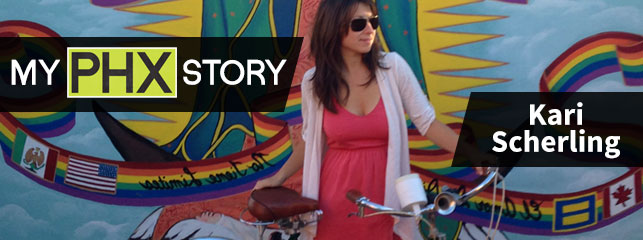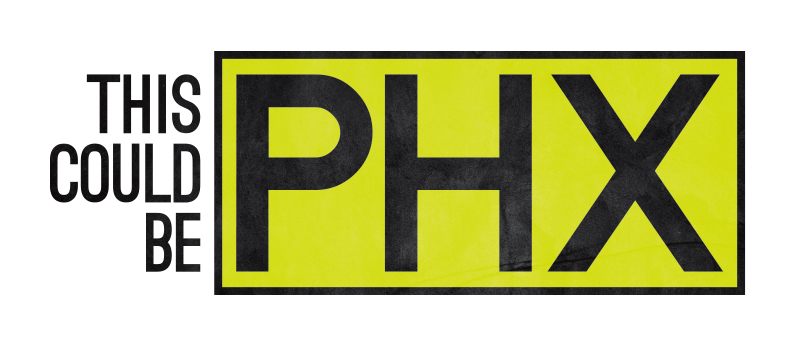
06 Nov My Phoenix Story: Kari Scherling
I have been on the move since I left Portland, Oregon nearly 10 years ago, looking for the perfect city. I made it to New York City and thought I had found it, but after a few years it felt like there had to be more. So I moved myself to a few cities in China then later to Mongolia, ending back in the states in the one-and-only, Detroit. I made a few, short-lived pit stops along the way in Minneapolis, San Francisco and Washington D.C.
With every new city and every new community I visited it always seemed as though there was a stream of likeness that ran through the people the environment and the infrastructure. One could pick out the unique characteristics, both organic and earned, that gave each city and each community their own identity. The buildings, the shops, the art and the parks all reflected an energy of the people and the culture which had proliferated the spaces.
Portland
In Portland, for example, the city itself is like a park with buildings in it, where houses have been mindfully placed throughout the clearings, embracing the large pines and the miniature old growth forests that line the sidewalks and the highways. This nature is a clear characteristic of Portlanders’ identity: they are people of the outdoors living to preserve what exists in bountiful form around them.
They have taken recycling to the next level, officially certifying extreme environmentalists to man the trash cans at concerts and direct people to recycle properly. They have turned a practice of reuse, rehabilitation and consignment into normal business culture. The celebration of art, the return to the local, and the micro-brewery movement all profess a city-wide appreciation for homegrown beauty and are characteristics of who Portlanders are as a whole and what they value.
New York
New York is a little harder to describe, mostly because it is a city of juxtapositions; it is larger than life at times but quietly quaint at others. It is both international and local, loud and quiet, so overwhelmingly generic yet expensively unique. The characteristics that define New York are more set in its long history, its narrative of influence, and the energy that is created when 8 million people are put on one island and each of them told to stand out. Simply walking down the street you can feel the energy rising from the 8 million people who make that city what it is.
You can’t always see them moving, singing, dancing, acting, drinking, writing, wheeling, dealing, but you can always feel it. It is not the nature that lives and breathes life into New Yorkers, but rather the narrative of what has been, is being and what could be. It is the long history as reminded by the historic buildings; it is the narrative of greatness as reminded by the legends, It is the energy of reinvention and the payoff of hard work that makes New York the city it is.
I speak to these two cities, because I know them intimately. But in all the other great cities I’ve visited I could feel the energy in the buildings, in the shops and in the creative unique spaces. Even Detroit, for as much bad press as it gets and how much people love to talk about its demise, is burgeoning with idea-filled energetic people whose innovation can be seen in the renovations of green spaces, the creative use of old neglected buildings and their epic Farmers Market.
Phoenix
Now how about Phoenix? If you had asked me a few years ago if I could live in Phoenix I would have smirked at the suggestion. An Oregonian hippy gone East Coast rogue? Not a chance. But having made the leap of faith, I have found something very special here, something I haven’t seen in other places: an engaged people who are actively trying to pull their city out of its awkward teen years, and collaborating, thinking forward and actively creating the city they want to live in, rather than reaping the benefits of its history or complaining about what it lacks.
Phoenix is young city but it has the potential to be a great one. It is unique in its climate that allows for bike riding nearly year round, its low living cost, its Wild Western history of rugged individualists. It has the energy of academia at its core and it has the opportunity for adventure in the mountains and rivers that lie just beyond its borders. With the technologies we have now, Phoenix could be one of the most interesting, progressive cities in the country. Harvesting its resources, building on its natural strengths and busting with its desert pride.
In a book called Cities are Good For You: Genius of the Metropolis the author Leo Hollis, an Urban Historian, asks this question: Can architecture liberate and nurture? Can buildings enhance and foster community or can it hinder and harm it? From my experience of living and finding community in two amazing cities, my vote would be, absolutely yes. There is absolutely a dialogue between the community and the buildings, one that reflects what that community has been and who it wants to be. A dialogue that reflects what the community values and what that community wants from itself, its best self.
What is Phoenix’s Best Self?
So what is Phoenix’s best self? Does anyone know yet? Phoenix is a community without an identity. But what is so exciting about being here, at this moment in its young history, is that people are engaging and constructing the urban identity day by day. The community is not apathetic; they are talking, imagining, and acting. They are re-envisioning the fenced in dirt lots, the run down auto body shops taking up whole city-blocks, and parking lots that are too large. People want to engage with the city, but the city has to return the energy and welcome the activities if you want community to grow. It is like an organism in that way, there are individual parts functioning in their own time and space, but they interconnect and are symbiotic in nature.
Taking Action
So how do we move from ideas to action? This website is a great way, sharing ideas, sharing the energy of hope, idealism, and faith in the community.
If I could share my idealist idea it would be this: using the ThisCouldBePHX platform to lead a crowd-sourced fundraising effort where we pledge to raise a million dollars for the renovation of a downtown space. Simultaneously, we solicit ideas of what that space could house and where it could be located from the community in suggestion boxes strategically placed throughout the city. By soliciting donations from the people of Phoenix and soliciting ideas, we can develop a sound assessment of what people want and we can say finitely what they wanted. Then using that strong base to seek out matching grants, state and city funds, and finally use that money to entice one (or a few) young, up and coming architects to create the first crowed sourced, community driven public space project.
For years planners and urban organizers have tried to create cities and urban spaces that reflect their OWN idea of what a city should be. And often times that is the job of the elected elite to decide. But the times have changed and we have so many platforms to discuss, to collect ideas and data, to fundraise and to be the ones to consciously and deliberately create the characteristics that will define our city.
So think big and speak loud: What do you think is Phoenix’s best self?




Sorry, the comment form is closed at this time.